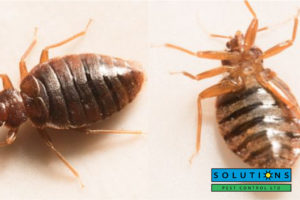The thought of bed bugs crawling around your mattress is enough to make anyone’s skin crawl — but catching them early can make all the difference. The real challenge? Baby bed bugs are incredibly tiny and can easily be mistaken for other pests or even go unnoticed entirely.
Whether you’re a homeowner, renter, or business owner, understanding how to identify these elusive pests in their early stages can save you time, stress, and money. In this article, we’ll break down what baby bed bugs look like, where to find them, and how to respond before they become a full-blown infestation.
What Do Baby Bed Bugs Look Like?
Also known as nymphs, baby bed bugs are newly hatched insects that go through several developmental stages before reaching adulthood. Their appearance can be easy to overlook because of their small size and translucent color.
Key Characteristics of Baby Bed Bugs:
- Size: Typically 1 to 1.5 millimeters long, about the size of a pinhead.
- Color: Pale or translucent when unfed, but turn reddish-brown after feeding.
- Shape: Oval and flat, much like adult bed bugs, but more difficult to spot due to their light coloring.
Because of their tiny size and color, baby bed bugs are often mistaken for small red bugs or dismissed as harmless debris. Knowing what you’re looking for is essential for early detection.
Where Do Baby Bed Bugs Hide?
Baby bed bugs are just as sneaky as the adults. They hide in the same cracks, crevices, and fabrics around your living space — especially where you sleep or rest.
Common Hiding Spots Include:
- Seams and folds in mattresses or box springs
- Behind headboards and wall hangings
- Cracks in bed frames or baseboards
- Inside couches, recliners, and upholstered furniture
- Electrical outlets, alarm clocks, and phone chargers
- Luggage, clothing, or used furniture brought into the home
Because they are nocturnal and light-sensitive, spotting baby bed bugs during the day requires a close, careful inspection of these areas.
Early Warning Signs of Baby Bed Bugs
Even if you don’t see the bugs themselves, you may notice other signs of their presence. Baby bed bugs feed on blood, just like adults, and leave behind telltale clues.
Watch for These Early Indicators:
- Tiny white or clear eggs: These are usually found in clusters and are about 1mm in size.
- Molted skins (exoskeletons): Bed bugs shed their skin at each life stage.
- Rust-colored or dark spots on sheets or mattresses: These are droppings or bloodstains from feeding.
- Tiny red bite marks: Often found in rows or clusters, especially on arms, legs, and neck.
If you notice any combination of these signs, it may be time to investigate further or call in a professional for a thorough inspection.
How to Differentiate Baby Bed Bugs from Other Small Bugs
It’s easy to confuse baby bed bugs with other tiny insects commonly found in homes. But identifying the correct pest is crucial for applying the right solution.
Baby Bed Bugs vs. Other Insects:
- Bed Bugs vs. Fleas: Fleas jump and are more rounded. Baby bed bugs crawl and are oval.
- Bed Bugs vs. Booklice: Booklice are soft-bodied and prefer moist areas. Baby bed bugs tend to be found near beds and are harder.
- Bed Bugs vs. Spider Mites or Carpet Beetles: These are often more colorful and found on plants or carpets, not in bedding.
If you’re unsure what type of bug you’re seeing, it’s always best to seek guidance from professionals who specialize in pest control services Richmond.
Why Spotting Baby Bed Bugs Early Matters
The earlier you detect bed bugs, the easier and less expensive it is to remove them. Baby bed bugs mature quickly — and each female adult can lay hundreds of eggs in her lifetime. Left unchecked, a small number of nymphs can quickly turn into a large, stubborn infestation that requires extensive treatment.
Catching them early:
- Reduces the spread throughout your home or building
- Helps avoid costly damage or replacements
- Limits health issues related to allergic reactions and insomnia
- Prevents embarrassment or negative experiences for visitors and tenants
Being proactive is your best line of defense. Don’t ignore signs or assume the problem will go away on its own.
How to Inspect for Baby Bed Bugs
A flashlight and a magnifying glass can be your best tools in the fight against early-stage bed bug infestations. Perform regular checks, especially after returning from a trip or bringing used furniture into your home.
DIY Inspection Tips:
- Remove and carefully inspect bed sheets, pillows, and mattress seams.
- Use a flashlight to check behind headboards and under furniture.
- Inspect corners, cracks, and joints of furniture.
- Check baseboards and edges of carpets for eggs or fecal spots.
Be thorough and methodical — and if you’re not confident in your findings, contact professionals experienced in pest control Richmond to perform a full evaluation.
What to Do if You Spot Baby Bed Bugs
If you discover baby bed bugs or evidence of an infestation, it’s important to act fast. While there are over-the-counter sprays and home remedies available, they often don’t reach deep into hiding spots or kill eggs effectively.
Immediate Actions:
- Wash and dry bedding and clothes on high heat
- Vacuum mattresses, furniture, and surrounding areas thoroughly
- Seal any cracks or gaps in walls or furniture
- Avoid moving infested items into other areas of your home
For long-term, reliable results, it’s wise to work with a professional pest control company that can customize a treatment plan to fit your specific situation.
About Solutions Pest Control
At Solutions Pest Control, we’re committed to protecting your home or business from even the most stubborn pests. Based in Richmond, BC, we specialize in safe, discreet, and effective bed bug treatments. Our trained technicians are experienced in detecting and eliminating baby bed bugs before they become a major problem.
From in-depth inspections to customized treatment solutions, we make it our mission to help you regain comfort and peace of mind.



